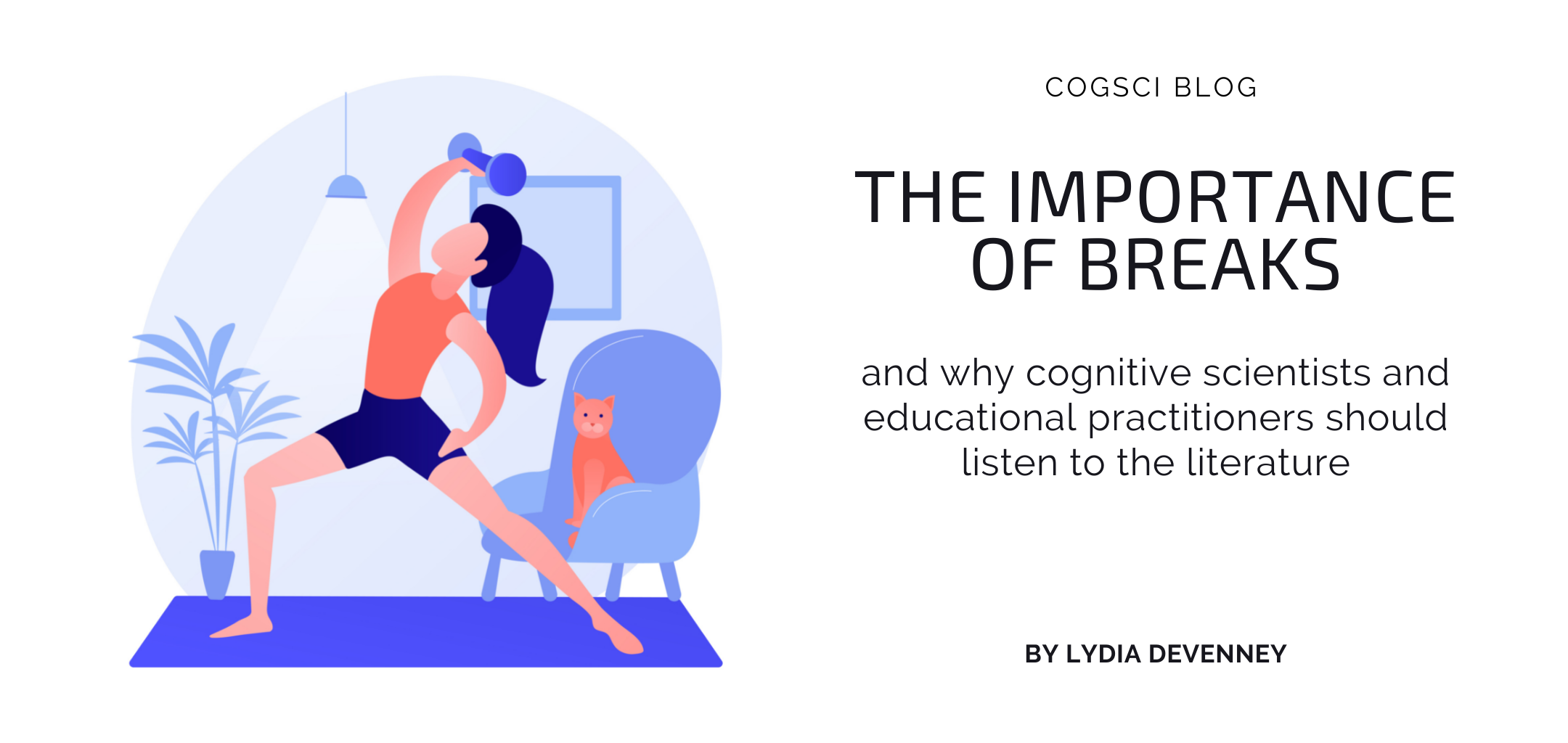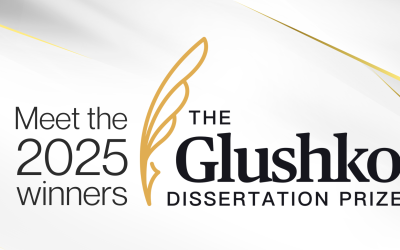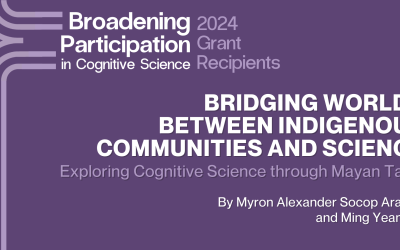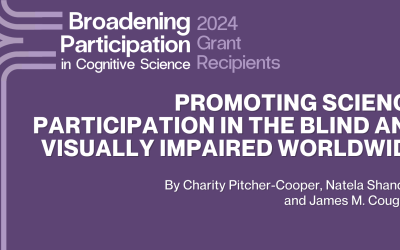The irony of writing about the importance of breaks, on what is historically a ‘day of rest’ (Sunday) is certainly not lost on me. The admission that early career researchers work far beyond their 40 hour a week temporary contracts is widely documented (Bozzon, Murgia, Poggio, & Rapetti, 2017; Sang, Powell, Finkel, & Richards, 2015; Susi, Shalvi & Srinivas, 2019). Good leaders discourage out of hours work, and some have come forward to suggest that you can have a successful career in academia by working within contracted time (Jongepier & van de Sande, 2021; Woolston, 2017). However, the list of experiences and skill sets required to ‘make it’ in academia is ever growing. It’s easy to believe the mantra that, “if I work harder, I’ll get to where I want to be…” but what do we mean by harder? And are we (cognitive scientists) listening to our own literature?
While many of us may not be in a position to change the academic ecosystem to one that asks for no more than a 9-5 hour work day, we can, however, take steps to optimise our cognitive functioning during work hours, and most importantly, promote healthy behaviours. To optimise cognitive performance, we should take short and regular physical activity breaks. Alternatively, mindfulness or relaxation and breathing breaks can also work to restore our focus (Im, Stavas, Lee, Mir, Hazlett-Stevens, & Caplovitz, 2021; Khng, 2017; Müller, Otto, Sawitzki, Kanagalingam, Scherer, & Lindberg, 2021).
The impact of physical activity brain breaks on cognitive performance has received more attention from researchers than mindfulness or relaxation and breathing brain breaks. In light of this, the successful implementation of physical activity breaks in the classroom and the often cited sedentary lifestyle of academics, this blog will discuss breaks relating to physical activity (Díaz-Silveira, Alcover, Burgos, Marcos & Santed, 2020; Faghy, Duncan, Pringle, Meharry, Roscoe, 2021; Pastor-Vicedo, Prieto-Ayuso, Pérez, & Martínez-Martínez, 2021).
EXERCISE THE COGNITIVE MUSCLE
Five minute physical activity breaks facilitate the restoration of neurotransmitters in the brain, increase arousal and stimulate neural connections creating a better environment for study (Iverson, 2019; Trudeau & Shephard, 2010). In terms of neurophysiology, movement predominantly benefits cognitive functioning via the prefrontal cortex. It is theorised that this occurs when the brain’s energy shifts from the prefrontal cortex to the motor cortex, striatum and the cerebellum during bouts of physical activity. When one returns to study, the prefrontal cortex experiences a rebound of oxygenated blood improving cognition (Dietrich and Audiffren, 2011). This is likely to be particularly beneficial to those who are at high risk of ‘Mind Wandering’ during long periods of study as a result of readily accessible technology (Nurgitz, 2019).
Moreover, during breaks, our diffused, task de-focussed or “default network” mode of thinking takes over. This provides an opportunity for important learning processes to occur. In a task-free or unsupervised state, we facilitate global brain network connections that are conducive to creative insight and self reflection (Bertoncelli Mayer & Lynass, 2016). Norman and Shallice’s theory of contention scheduling of automated behaviours (such as jogging in healthy individuals) involves the activation of the default network (Ceislik, Mueller, Eickhoff, Langner, & Eickhoff, 2015; Norman, & Shallice, 1986). Indeed, such automated actions that do not require novel or complex responses result in greater activity as well as connectivity in the default mode network (Vatansever, Menon & Stamatakis, 2017). In support of this, physical activity has been shown to enhance creativity, a phenomenon at the core of research (closely linked to quantitative reasoning, formulating new questions and combining unrelated knowledge) independently from positive affect (Barrow, 2010; Rominger, Fink, Weber, Papousek & Schwerdtfeger, 2020; Uilibarri, Cravens, Nabergoj, Kernbach & Royalty, 2019).
The neurochemicals involved in the interaction between physical activity and the brain are considerable, and include lactate, cortisol, neurotrophins, BDNF, IGF-1, VEGF, dopamine, norepinephrine, serotonin, acetylcholine, GABA, glutamate, endogenous opioids and endocannabinoid (see Basso & Suzuki, 2017 for a detailed account). Therefore, it is of no surprise that in addition to cognitive advantages, benefits of physical activity breaks include improved mood, vascular functioning, self-efficacy, emotional regulation, engagement, physical health, disease inclusive of computer vision syndrome prevention, and motivation (Blehm, Vishnu, Khattak, Mitra, & Yee, 2005; Daly-Smith, Zwoolinsky, McKenna et al., 2018; Ferman & Laughlin, 2017; Warburton, Nicol & Bredin, 2006). Considering the prevalence of mental health challenges and burnout in academia, the immediate and long term benefits of taking short physical activity breaks could be vast (Byrom, 2020; Fowler, 2015; Watts & Robertson, 2010).
IF FORMAL EDUCATION CAN, WE CAN TOO
As scientists and higher educational practitioners, informal learning is a fundamental part of our job role. The translation of cognitive research in formal learning environments can be seen in classrooms across the world. In recent years, educational research has demonstrated that traditional ‘still’ classroom designs are suboptimal in the facilitation of active learning and engagement, which has drawn attention to the beneficial role of physical activity in the learning experience. Indeed, short physical activity breaks have been successfully implemented to improve behavioural, cognitive and learning outcomes in primary, secondary and tertiary level education (Daly-Smith, Zwoolinsky, McKenna et al., 2018; Fenesi, Lucibello, Kim & Heisz, 2017; Ferrer & Laughlin, 2017; Lambez, Harwood-Gross, Golumbic & Rassovsky, 2020). Given the success of physical activity breaks in formal learning, it is proposed that such breaks are adopted across the entire academic lifespan. The practice among scientists and higher educational practitioners of optimising classroom learning for students through physical activity breaks but not for our own cognitive functioning when back at our desk, is puzzling. Higher order thinking (e.g. analysing, evaluating, critical thinking and problem solving) is at the nub of both scientific research and formal education. Thus, the cognitive systems activated (e.g. executive functioning, attention, memory) during scientific research are likely to be comparable to those engaged during formal education. If the benefits showcased in education are substantial, shouldn’t we consider the promotion of short exercise breaks in research communities too?
CONCLUSION
The paradoxical reality is that working on cognitively demanding tasks for long periods without breaks will not produce better results than when working for shorter periods with breaks. We may best contribute to the field of cognitive science, by reflecting on cognitive science, and taking those much needed breaks!
HOW TO
Short breaks can consist of as little as five 50-s calisthenic exercises (e.g jumping jacks, heeltaps, high knees, split jumps, burpees, squats, mountain climbers or a jog around the block) each separated by a 10 second rest (Fenesi, Lucibello, Kim & Heisz, 2017; Booth, Tomporowski, Boyle, Ness, Joinson, Leary, & Reilly, 2013; Loras, Haga & Sigmundsson, 2020). There is not yet an agreed evidence based consensus on the optimum time for adults to take breaks. This is likely to be dependent on the task at hand and one’s concentration. However, it is recommended that a break is taken each time you begin to experience mind wandering or become disengaged with the task, this often occurs every 20-50 minutes.
REFERENCES
Barrow, L. H. (2010). Encouraging creativity with scientific inquiry. Creative Education, 1(1), 1-6.
Basso, J. C., & Suzuki, W. A. (2017). The effects of acute exercise on mood, cognition, neurophysiology, and neurochemical pathways: a review. Brain Plasticity, 2(2), 127-152.
Bertoncelli, T., Mayer, O., & Lynass, M. (2016). Creativity, learning techniques and TRIZ. Procedia Cirp, 39, 191-196.
Blehm, C., Vishnu, S., Khattak, A., Mitra, S., & Yee, R. W. (2005). Computer vision syndrome: a review. Survey of Ophthalmology, 50(3), 253-262.
Booth, J. N., Tomporowski, P. D., Boyle, J. M., Ness, A. R., Joinson, C., Leary, S. D., & Reilly, J. J. (2013). Associations between executive attention and objectively measured physical activity in adolescence: findings from ALSPAC, a UK cohort. Mental Health and Physical Activity, 6(3), 212-219.
Bozzon, R., Murgia, A., Poggio, B., & Rapetti, E. (2017). Work–life interferences in the early stages of academic careers: The case of precarious researchers in Italy. European Educational Research Journal, 16(2-3), 332-351.
Byrom, N. (2020). COVID-19 and the Research Community: The challenges of lockdown for early-career researchers. Elife, 9, e59634.
Cieslik, E. C., Mueller, V. I., Eickhoff, C. R., Langner, R., & Eickhoff, S. B. (2015). Three key regions for supervisory attentional control: evidence from neuroimaging meta-analyses. Neuroscience & biobehavioral reviews, 48, 22-34.
Daly-Smith, A. J., Zwolinsky, S., McKenna, J., Tomporowski, P. D., Defeyter, M. A., & Manley, A. (2018). Systematic review of acute physically active learning and classroom movement breaks on children’s physical activity, cognition, academic performance and classroom behaviour: understanding critical design features. BMJ open sport & exercise medicine, 4(1), e000341.
Díaz-Silveira, C., Alcover, C. M., Burgos, F., Marcos, A., & Santed, M. A. (2020). Mindfulness versus Physical Exercise: Effects of Two Recovery Strategies on Mental Health, Stress and Immunoglobulin A during Lunch Breaks. A Randomized Controlled Trial. International journal of Environmental Research and Public Health, 17(8), 2839.
Dietrich, A., & Audiffren, M. (2011). The reticular-activating hypofrontality (RAH) model of acute exercise. Neuroscience & Biobehavioral Reviews, 35(6), 1305-1325.
Faghy, M. A., Duncan, M. J., Pringle, A., Meharry, J. B., & Roscoe, C. M. P. (2021). UK university staff experience high levels of sedentary behaviour during work and leisure time. International Journal of Occupational Safety and Ergonomics, 1-8.
Fenesi, B., Lucibello, K., Kim, J. A., & Heisz, J. J. (2018). Sweat so you don’t forget: exercise breaks during a university lecture increase on-task attention and learning. Journal of Applied Research in Memory and Cognition, 7(2), 261-269.
Ferrer, M. E., & Laughlin, D. D. (2017). Increasing College Students’ Engagement and Physical Activity with Classroom Brain Breaks: Editor: Ferman Konukman. Journal of Physical Education, Recreation & Dance, 88(3), 53-56.
Fowler, S. (2015). Burnout and depression in academia: A look at the discourse of the university. Empedocles: European Journal for the Philosophy of Communication, 6(2), 155-167.
Im, S., Stavas, J., Lee, J., Mir, Z., Hazlett-Stevens, H., & Caplovitz, G. (2021). Does mindfulness-based intervention improve cognitive function?: A meta-analysis of controlled studies. Clinical Psychology Review, 101972.
Iverson, R. (2019). The Impact of Physical Activity Breaks in the Classroom. [Master of Education, Northwestern College]. Nwcommons. nwcommons.nwciowa.edu/education_masters/181/
Jones, N (2003). I can [Released by Nas]. On God’s Son [Mp3 file]. New York, United States: Columbia Records
Jongepier, F., & van de Sande, M. (March, 2021). Workaholic academics need to stop taking pride in their burnout. Times Higher Education, 2021. https://www.timeshighereducation.com/opinion/workaholic-academics-need-stop-taking-pride-their-burnout
Khng, K. H. (2017). A better state-of-mind: deep breathing reduces state anxiety and enhances test performance through regulating test cognitions in children. Cognition and Emotion, 31(7), 1502-1510.
Lambez, B., Harwood-Gross, A., Golumbic, E. Z., & Rassovsky, Y. (2020). Non-pharmacological interventions for cognitive difficulties in ADHD: A systematic review and meta-analysis. Journal of psychiatric research, 120, 40-55.
Lorås, H., Haga, M., & Sigmundsson, H. (2020). Effect of a single bout of acute aerobic exercise at moderate-to-vigorous intensities on motor learning, retention and transfer. Sports, 8(2), 15.
Müller, C., Otto, B., Sawitzki, V., Kanagalingam, P., Scherer, J. S., & Lindberg, S. (2021). Short breaks at school: effects of a physical activity and a mindfulness intervention on children’s attention, reading comprehension, and self-esteem. Trends in Neuroscience and Education, 25, 100160.
Norman, D. A., & Shallice, T. (1986). Attention to action. In Consciousness and self-regulation (pp. 1-18). Springer, Boston, MA.
Nurgitz, R. (2019). Mind Wandering and Academic Success: Insight into Student Learning and Engagement.
Pastor-Vicedo, J. C., Prieto-Ayuso, A., Pérez, S. L., & Martínez-Martínez, J. (2021). Active Breaks and Cognitive Performance in Pupils: A Systematic Review. Apunts. Educació Física i Esports, (146), 11-23.
Rominger, C., Fink, A., Weber, B., Papousek, I., & Schwerdtfeger, A. R. (2020). Everyday bodily movement is associated with creativity independently from active positive affect: a Bayesian mediation analysis approach. Scientific Reports, 10(1), 1-9.
Sang, K., Powell, A., Finkel, R., & Richards, J. (2015). ‘Being an academic is not a 9–5 job’: long working hours and the ‘ideal worker’in UK academia. Labour & Industry: a journal of the social and economic relations of work, 25(3), 235-249.
Susi, T., Shalvi, S., & Srinivas, M. (2019). I’ll work on it over the weekend’: high workload and other pressures faced by early-career researchers. Nature, 2019, 197735355.
Trudeau, F., & Shephard, R. J. (2010). Relationships of physical activity to brain health and the academic performance of schoolchildren. American Journal of Lifestyle Medicine, 4(2), 138-150.
Ulibarri, N., Cravens, A. E., Nabergoj, A. S., Kernbach, S., & Royalty, A. (2019). Creativity in research. Cambridge University Press.
Vatansever, D., Menon, D. K., & Stamatakis, E. A. (2017). Default mode contributions to automated information processing. Proceedings of the National Academy of Sciences, 114(48), 12821-12826.
Warburton, D. E., Nicol, C. W., & Bredin, S. S. (2006). Health benefits of physical activity: the evidence. Canadian Medical Association Journal, 174(6), 801-809.
Woolston, C. (2017). Graduate survey: A love–hurt relationship. Nature, 550(7677), 549-552.




